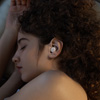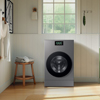 Researchers at the University of Leicester have witnessed for the first time the damage that noises over 110 decibels can cause to nerve cells—sound levels earphones can generate when turned up too high. Lead researcher Dr. Martine Hamann explains, "Nerve cells that carry electrical signals from the ears to the brain have a coating called the myelin sheath, which helps the electrical signals travel along the cell. Exposure to loud noises - i.e. noise over 110 decibels - can strip the cells of this coating, disrupting the electrical signals. This means the nerves can no longer efficiently transmit information from the ears to the brain." Resulting hearing problems can include temporary deafness and tinnitus, or ringing in the ears.
Researchers at the University of Leicester have witnessed for the first time the damage that noises over 110 decibels can cause to nerve cells—sound levels earphones can generate when turned up too high. Lead researcher Dr. Martine Hamann explains, "Nerve cells that carry electrical signals from the ears to the brain have a coating called the myelin sheath, which helps the electrical signals travel along the cell. Exposure to loud noises - i.e. noise over 110 decibels - can strip the cells of this coating, disrupting the electrical signals. This means the nerves can no longer efficiently transmit information from the ears to the brain." Resulting hearing problems can include temporary deafness and tinnitus, or ringing in the ears.
The good news is that the researchers found that nerve cells' myelin sheathes can recover over of a period of about three months. These findings could lead to better means of prevention and a cure for some types of hearing loss.
Of course, it’s best if you never damage your hearing in the first place.
Most music players max out at about 103 decibels (dB), though some can reach sound levels of up to 120dB, which is like standing 100 feet behind the engine of a jet plane as it's taking off. According to the National Institute on Deafness and Other Communication Disorders (NIDCD), more than a minute of exposure to 110 dB (ex. a chain saw) risks permanent hearing loss, as can 15 minutes at 100dB or prolonged exposure at or above 85dB.
If you’re not sure how loud your music player is, try turning it all the way up. If you can’t hear someone talking to you in the same room, the volume is too loud.
As a general rule, you shouldn’t turn the volume up to more than 75 percent of your device’s maximum level. For iOS devices, you can set a volume limit under the music settings.
Also, make sure your earphones fit properly; earphones naturally block ambient sound, so you won’t need to turn the volume up as high. Try holding the earphones in place to see if you’re getting a good seal. If you’re not, experiment with the tips that came with your earphones, keeping in mind that one ear may be slightly larger than the other and need different size tips.
And if you’re in the market for new earphones, look at the output decibel rating. Most will max out at around 100dB, but some offer sound limiting, especially earphones designed for kids; these earphones should only go up to 85dB.
Finally, take periodic 15 to 20 minute breaks when listening at high volume to let the inner ear recover.















From Betsy Cadel on September 05, 2012 :: 11:12 am
Thank you so much for this article. I am hoping it puts an end to the “turn down your music” debate when my son is wearing his headphones and I can still hear the music.
Reply